
In the ever-evolving world of interior design, mirrors have emerged as versatile assets that transcend their traditional role as mere functional accessories. These shimmering surfaces have the power to transform the ambiance of any space, serving as captivating focal points that amplify the play of light and create an illusion of depth and grandeur.
The Reflective Magic of Mirrors
Mirrors work their design magic through the principle of reflection, a fundamental concept in the science of optics. When light strikes a smooth, shiny surface, it bounces back at the same angle as it hit the surface, a phenomenon known as specular reflection. This property allows mirrors to create captivating visual effects, from doubling the perceived size of a room to accentuating the natural illumination in a space.
According to the Science Learning Hub, the angle at which light hits a reflecting surface, known as the angle of incidence, is exactly the same as the angle at which the light bounces off, or the angle of reflection. This predictable behavior of light is what gives mirrors their remarkable ability to reflect images accurately and create the illusion of depth.
Strategically Positioning Mirrors for Maximum Impact
The placement of mirrors within a space is crucial in determining their design impact. Savvy interior designers leverage the reflective properties of mirrors to enhance and amplify the existing lighting in a room, creating a harmonious and visually captivating environment.
One effective strategy is to position mirrors opposite or adjacent to natural light sources, such as windows or skylights. This allows the mirrors to catch and reflect the abundant daylight, creating a bright and airy atmosphere. Additionally, strategically placing mirrors near artificial light sources, such as chandeliers or sconces, can help to distribute the illumination more evenly throughout the room, creating a balanced and inviting ambiance.
As discussed on Reddit, the type of mirror surface can also play a significant role in the quality of the reflection. Concave mirrors, which curve inward like the inside of a spoon, have the ability to focus and concentrate light, making them an excellent choice for task lighting in areas like vanities or home offices. Conversely, convex mirrors, which curve outward, can create a wider field of vision, making them ideal for enhancing spatial perception in smaller rooms or entryways.
Incorporating Mirrors as Lighting Focal Points
The strategic placement of mirrors can transform them into captivating focal points that elevate the overall design of a space. Here are some creative ways to incorporate mirrors as lighting focal points:
Mirrored Feature Walls
Dedicating an entire wall to a large, statement mirror can create a dramatic and visually-striking centerpiece. This design approach is particularly effective in open-concept living areas or foyers, where the mirror can reflect and amplify the natural or artificial light, creating an illusion of depth and grandeur.
Clustered Mirror Arrangements
Grouping multiple mirrors of varying sizes and shapes can also form a visually-arresting focal point. This technique allows you to play with reflection and refraction, creating a unique and eye-catching display that can serve as a captivating design feature.
Mirrored Furniture and Accessories
Incorporating mirrored surfaces into furniture and decor, such as console tables, side tables, or even light fixtures, can help to scatter and amplify the illumination in a space. These reflective elements can add a touch of glamour and sophistication to any room.
According to The Physics Classroom, convex mirrors are particularly useful for enhancing spatial perception, as they create virtual images that appear smaller and more wide-angled than the actual object. This makes them an ideal choice for entryways, hallways, or small bathrooms, where they can help to visually expand the perceived size of the space.
Lighting Considerations for Mirror Placement
When positioning mirrors as lighting focal points, it’s crucial to consider the type and placement of the light sources to create a harmonious and visually appealing design.
Ambient lighting, such as ceiling-mounted fixtures or wall sconces, can help to bathe the mirror in a warm and even glow, ensuring that the reflection is neither too harsh nor uneven. Strategically placed task lighting, like vanity lights or recessed fixtures, can also enhance the functionality of mirrors in areas where precise illumination is required, such as bathrooms or dressing rooms.
In addition to artificial lighting, natural light can play a significant role in the design of mirror-centric spaces. Urban Grace Interiors Inc. suggests positioning mirrors across from windows or skylights to capture and reflect the abundant daylight, creating a bright and airy ambiance.
Elevating Luxury and Sophistication with Mirrors
The strategic use of mirrors as lighting focal points can infuse any space with a sense of luxury and sophistication. By carefully considering the placement, type, and lighting associated with these reflective surfaces, interior designers can create visually-captivating environments that evoke a feeling of grandeur and opulence.
Whether it’s a mirrored feature wall that reflects the natural light of a sunlit living room, a cluster of mirrors that scatter the illumination of a chandelier, or a mirrored console table that amplifies the glow of sconce lighting, the possibilities for incorporating mirrors as lighting focal points are endless. By mastering the art of reflection, interior designers can transform ordinary spaces into extraordinary and breathtaking sanctuaries of light and design.

